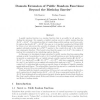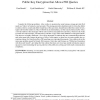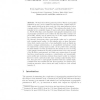101
Voted
CRYPTO
2007
Springer
15 years 7 months ago
2007
Springer
We introduce a variant of the random oracle model where oracle-dependent auxiliary input is allowed. In this setting, the adversary gets an auxiliary input that can contain informa...
114
Voted
CRYPTO
2007
Springer
15 years 7 months ago
2007
Springer
A public random function is a random function that is accessible by all parties, including the adversary. For example, a (public) random oracle is a public random function {0, 1}ā...
82
Voted
CRYPTO
2007
Springer
15 years 7 months ago
2007
Springer
At Crypto ā06, Bellare presented new security proofs for HMAC and NMAC, under the assumption that the underlying compression function is a pseudo-random function family. Converse...
76
Voted
CRYPTO
2007
Springer
15 years 7 months ago
2007
Springer
Wienerās famous attack on RSA with d < N0.25 shows that using a small d for an eļ¬cient decryption process makes RSA completely insecure. As an alternative, Wiener proposed t...
105
click to vote
CRYPTO
2007
Springer
15 years 7 months ago
2007
Springer
Coppersmith described at Eurocrypt 96 an algorithm for ļ¬nding small roots of bivariate integer polynomial equations, based on lattice reduction. A simpler algorithm was later pro...
89
Voted
CRYPTO
2007
Springer
15 years 7 months ago
2007
Springer
In this paper we identify the (P, Q)-DDH assumption, as an extreme, powerful generalization of the Decisional Diļ¬e-Hellman (DDH) assumption: virtually all previously proposed gen...
104
Voted
CRYPTO
2007
Springer
15 years 7 months ago
2007
Springer
Abstract. This paper introduces simulatable veriļ¬able random functions (sVRF). VRFs are similar to pseudorandom functions, except that they are also veriļ¬able: corresponding to...
86
Voted
CRYPTO
2007
Springer
15 years 7 months ago
2007
Springer
66
Voted
CRYPTO
2007
Springer
15 years 7 months ago
2007
Springer
127
click to vote
CRYPTO
2007
Springer
15 years 7 months ago
2007
Springer
Round complexity is a central measure of eļ¬ciency, and characterizing the round complexity of various cryptographic tasks is of both theoretical and practical importance. We show...






